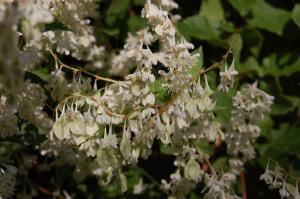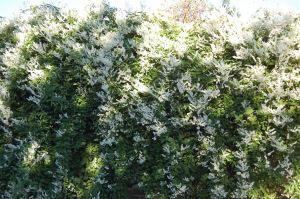
Polygonum baldschuanicum flower (15/10/2011, London)
Position: Full sun to partial shade
Flowering period: Summer to early autumn
Soil: Well drained
Eventual Height: 15m
Eventual Spread: 12m
Hardiness: USDA Zones 4a-9b
Family: Polygonaceae
Polygonum baldschuanicum is a vigorous, twining deciduous climber. The plant has pointed oval to triangular leaves up to 10 centimeters long. They are borne on petioles and are dark green in colour. The flowers of the plant appear in panicles of tiny, funnel-shaped, pink tinged white flowers in summer to early autumn. The flower cluster reaches a length of 15 centimeters long. They hang on short pedicels, and each 5 lobed flower is just under a centimeter long. The fruit is a shiny black achene about 2 millimeters wide. The stems are woody.
Polygonum baldschuanicum, commonly known as the Russian Vine, Bukhara Fleeceflower, Chinese Fleecevine, Mile-A-Minute or Silver Lace Vine, is native to Asia, particularly western China and Tibet. P. baldschuanicum is synonymus with Fallopia baldschuanica.It can be found growing in the wild in parts of Europe and North and Central America as an introduced species. This plant is used as a fast growing ornamental plant but it does have the capacity to become an invasive species. There are ecological concerns at the invasive nature of this plant.
The etymology of the binomial name Polygonum is derived from the Greek polys meaning ‘many’ and gonia meaning ‘knee’ in reference to the many swollen jointed stem nodes. Baldschuanicum is derived from the Latin meaning ‘from Baldschuan’ or Bokhara, Uzbekistan, the region of the provenance of this plant.

Polygonum baldschuanicum (15/10/2011, London)
The landscape architect may find Polygonum baldschuanicum useful when vigorous self twining climber is required. Care should be taken in the location of this plant due to it’s extremely vigorous nature, it requires a lot of space.
Ecologically Polygonum baldschuanicum is attractive to a wide range of moths, also bees like it due to its generous supply of nectar and pollen. It can form excellent nesting site for birds.
Polygonum baldschuanicum will tolerate most soil types, including acidic, loamy and chalky soils.
Maintenance: It may be pruned at any time of year.
Advertisement Eco World Content From Across The Internet.

